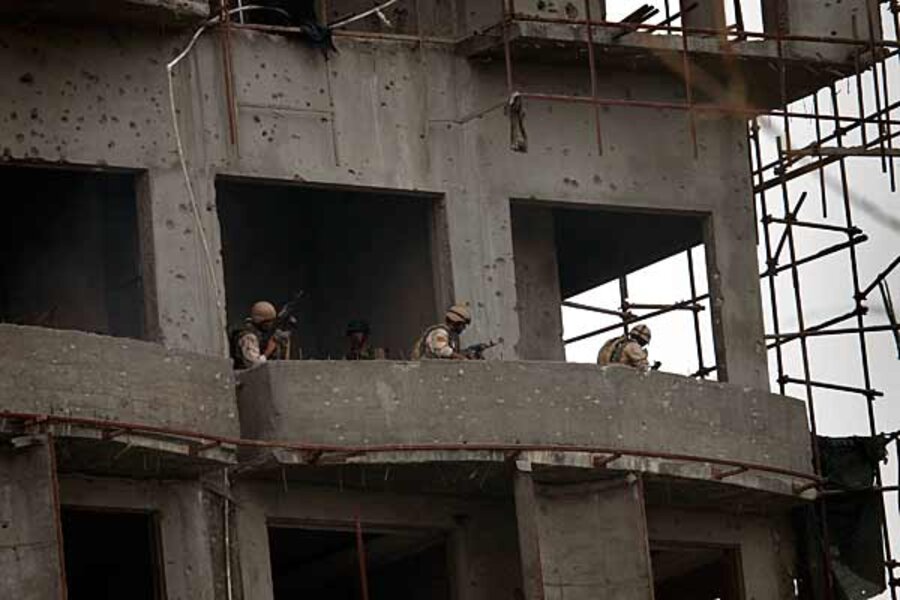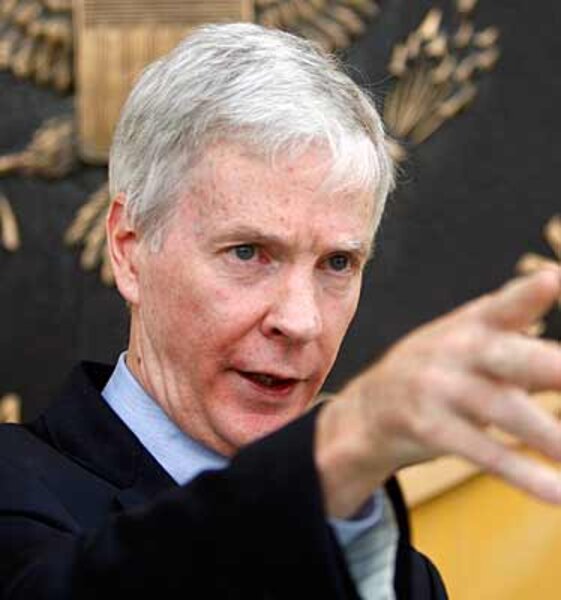Who's really behind the Kabul attacks?
Loading...
| New Delhi
US Ambassador to Afghanistan Ryan Crocker blamed the Taliban faction known as the Haqqani Network for a 20-hour terror attack in the heart of Kabul, despite broader Taliban claims of responsibility.
Some analysts view the US coalition’s focus on blaming the Haqqani faction for many recent attacks around Kabul to be a tactic to salvage nascent peace negotiations with the Taliban's more mainstream leaders.
“These are really joint attacks by all these groups. What [the US-led coalition] ISAF has suddenly done is they’ve pivoted due to negotiations, or talks of negotiations, and they are sort of trying to leave the Haqqani Network as the outlier,” says Bill Roggio, editor of the online Long War Journal.
Top US and NATO officials have been laying blame on the Haqqanis for most of the major terror attacks in and around Kabul this year. These include the June attack on the InterContinental Hotel and a truck bombing over the weekend in Wardak that injured nearly 80 American soldiers.
Taliban spokesman Zabihullah Mujahid has claimed responsibility for all of these attacks in the name of the insurgency as a whole. Mullah Omar leads the overall Taliban movement with a leadership cadre known as the Quetta Shura. Factions like the Haqqani Network and Hizb-e-Islami have sworn allegiance to Mr. Omar and fall under the Taliban umbrella.
Most radical faction?
Mr. Roggio, along with most analysts of the insurgency, agrees that the Haqqani Network is the most radical of the factions with the greatest capability to strike Kabul.
The group is headed by Jalaluddin Haqqani and run by his son Sirajuddin out of Pakistan’s North Waziristan tribal agency. Long before the Taliban movement emerged, Jalaluddin amassed tremendous influence as an anti-Soviet mujahideen commander. He hosted foreign fighters who would go on to form Al Qaeda, forging ties that endure today.
Those familiar with the peace process indicate that US officials view the Haqqani Network as irreconcilable given those Al Qaeda links, as opposed to elements within the Quetta Shura. This has upset Pakistan, whose top general once called Jalaluddin an “asset.”
While the Haqqani Network’s base lies close to Kabul, Mr. Roggio says the group cooperates with other Taliban leaders and may use foot soldiers from other factions like Hizb-e-Islami to carry out dramatic attacks in the Kabul region.
Until recently, that had also been the public stance of US officials who would pin such attacks on this same mixture, dubbing it the Kabul Attack Network.
“All of the sudden sometime this spring, the term Kabul Attack Network went away,” says Roggio. “They won’t use it in their press releases. Now they just blame things on the Haqqani Network.”
Negotiation for peace
Serious negotiations between the US and a representative from the Quetta Shura started this spring.
The US Embassy in Kabul said it could not comment on this before press time. It released a transcript of an interview with the ambassador in which he urged Pakistan to put pressure on Taliban groups.
“The information available to us, is that these attackers, like those who carried out the bombing in Wardak are part of the Haqqani Network, they enjoy safe haven in Northern Waziristan,” said Ambassador Crocker. “It’s in the long term interest of Pakistan … to bring these groups under control.”
He called the attacks, which left 27 dead, “minor league stuff" and said he hoped that the Taliban would decide to move away from these attacks, break with Al Qaeda, and accept the Afghan Constitution.
The Taliban themselves offer some reason to believe the view that the recent string of major attacks in Kabul involve more than one faction.
In an interview with the Monitor after the InterContinental attack, Mr. Mujahid claimed that the man in charge of the operation was the Kabul shadow governor, but he declined to name the main commander on the ground. The Quetta Shura appoints these shadow governors for each of the country’s provinces. NATO blamed the attack on the Haqqanis.
The lack of transparency about the Taliban means it’s not altogether clear who Mujahid speaks with and speaks for. He claims to speak for the entire movement, not just any one faction. Statements from the Taliban are often inflated and not reliable.
Other analysts including Ahmed Rashid, author of the book “Descent into Chaos,” speculate that the Haqqani Network may be launching these brazen attacks on Kabul in their own effort to shut down the US overtures to the likes of Quetta Shura. If such divisions are emerging between the factions, the Taliban claims of responsibility by Mujahid have helped keep those tensions hidden.






